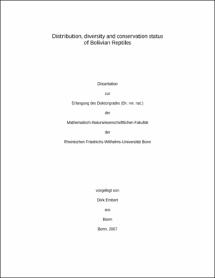Distribution, diversity and conservation status of Bolivian Reptiles


| dc.contributor.advisor | Böhme, Wolfgang | |
| dc.contributor.author | Embert, Dirk | |
| dc.date.accessioned | 2020-04-12T14:47:21Z | |
| dc.date.available | 2020-04-12T14:47:21Z | |
| dc.date.issued | 2008 | |
| dc.identifier.uri | https://hdl.handle.net/20.500.11811/3619 | |
| dc.description.abstract | The study area was defined as being the whole country of Bolivia. The Conservation Status of Bolivian Reptiles has been poorly investigated. Very few species had been assessed by the IUCN and very few were listed in CITES. As Bolivia still is within the countries with best conserved habitat, now is the moment to plan the conservation of its Biodiversity. This makes the present study urgent and necessary. | en |
| dc.language.iso | eng | |
| dc.rights | In Copyright | |
| dc.rights.uri | http://rightsstatements.org/vocab/InC/1.0/ | |
| dc.subject | Naturschutzstatus | |
| dc.subject | Bolivien | |
| dc.subject | Reptilien | |
| dc.subject | Verbreitung | |
| dc.subject | Südamerika | |
| dc.subject | Neotropen | |
| dc.subject | Reptilia | |
| dc.subject | Diversität | |
| dc.subject | Artenreichtum | |
| dc.subject | Endemismus | |
| dc.subject | Fragmentierung | |
| dc.subject | IUCN | |
| dc.subject | Eidechsen | |
| dc.subject | Schlangen | |
| dc.subject | Krokodile | |
| dc.subject | Schildkröten | |
| dc.subject | Conservation status | |
| dc.subject | Bolivia | |
| dc.subject | Reptiles | |
| dc.subject | Distribution | |
| dc.subject | Southamerica | |
| dc.subject | Neotropics | |
| dc.subject | Reptiles | |
| dc.subject | Diversity | |
| dc.subject | Species Richness | |
| dc.subject | Endemism | |
| dc.subject | Fragmentation | |
| dc.subject | Lizards | |
| dc.subject | Snakes | |
| dc.subject | Caimans | |
| dc.subject | Alligators | |
| dc.subject | Turtles | |
| dc.subject.ddc | 590 Tiere (Zoologie) | |
| dc.title | Distribution, diversity and conservation status of Bolivian Reptiles | |
| dc.type | Dissertation oder Habilitation | |
| dc.publisher.name | Universitäts- und Landesbibliothek Bonn | |
| dc.publisher.location | Bonn | |
| dc.rights.accessRights | openAccess | |
| dc.identifier.urn | https://nbn-resolving.org/urn:nbn:de:hbz:5N-14415 | |
| ulbbn.pubtype | Erstveröffentlichung | |
| ulbbnediss.affiliation.name | Rheinische Friedrich-Wilhelms-Universität Bonn | |
| ulbbnediss.affiliation.location | Bonn | |
| ulbbnediss.thesis.level | Dissertation | |
| ulbbnediss.dissID | 1441 | |
| ulbbnediss.date.accepted | 29.11.2007 | |
| ulbbnediss.fakultaet | Mathematisch-Naturwissenschaftliche Fakultät | |
| dc.contributor.coReferee | Kneitz, Gerhard |
Dateien zu dieser Ressource
Das Dokument erscheint in:
-
E-Dissertationen (4368)




